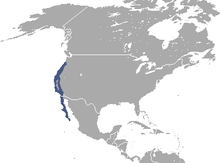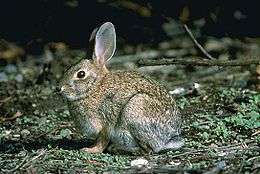Brush rabbit
| Brush rabbit[1] | |
|---|---|
| | |
| Brush rabbit (Finley National Wildlife Refuge) | |
| Scientific classification | |
| Kingdom: | Animalia |
| Phylum: | Chordata |
| Class: | Mammalia |
| Order: | Lagomorpha |
| Family: | Leporidae |
| Genus: | Sylvilagus |
| Species: | S. bachmani |
| Binomial name | |
| Sylvilagus bachmani (Waterhouse, 1839) | |
 | |
| Brush rabbit range | |
The brush rabbit (Sylvilagus bachmani), or western brush rabbit, or californian brush rabbit,[3] is a species of cottontail rabbit found in western coastal regions of North America, from the Columbia River in Oregon to the southern tip of the Baja California Peninsula. Its range extends as far east as the eastern sides of the Sierra Nevada and Cascade mountain ranges
Habitat
The brush rabbit inhabits dense, brushy cover, most commonly in chaparral vegetation. It also occurs in oak and conifer habitats and it will live in brush or grassland, and form networks of runways through the vegetation. The brush rabbit does not dig its own burrow or den, but uses the burrow of other species, brush piles, or forms. In the San Francisco Bay Area, it was found that the brush rabbit concentrates its activities at the edge of brush and exhibits much less use of grassy areas. It uses the interior brush of the wilderness and it was also found that this may be a better environment for it than the chaparral one. Studies done on the brush rabbit in Oregon also showed that it rarely left the brushy areas it inhabits. Brush may be used more in the drier seasons while grasses are used in the wetter seasons in relation to growth of annual vegetation. Use of habitat also probably is related to the breeding season.
Physical description

The brush rabbit is smaller than many of the other cottontails, and unlike most of them, the underside of its tail is grey rather than white (which may be why its common name does not include the word "cottontail"). The upperside of the brush rabbit's fur varies from light brown to gray in color, while the underside is usually always white. Adult rabbits measure anywhere from 10–14 inches long and rarely weigh over two pounds.
Large numbers of geographically defined subspecies have been proposed, including in Oregon, ubericolor; in California, cinerascens, mariposae, riparius, tehamae and trowbridgii; and in Baja California, cerrosensis, exiguus, howelli, peninsularis and rosaphagus. Subspecies bachmani, macrorhinus and virgulti are less geographically restricted. Sylvilagus bachmani riparius, the riparian brush rabbit, is highly endangered; formerly numerous along the San Joaquin River and Stanislaus River, it is now reduced to a population of a few hundred in the Caswell Memorial State Park. Of the various proposed subspecies, only the following are currently recognized; the others are synonyms: S. b. ubericolor, S. b. cinerascens, S. b. bachmani, S. b. exiguus, S. b. howelli, S. b. cerrosensis.[1]
It has been noted that numbers of the eastern cottontail were brought west to reproduce and provide a food source for the settlers. The interbreeding of the two species has occurred where the Brush Rabbit has in parts of Oregon developed the white cottontail although retaining its smaller size.
Reproduction
Brush rabbit mating, as with other rabbits, may occur year-round but peak breeding seasons are between February and August. The gestation period of the brush rabbit female is about 22 days. A female brush rabbit can have as many as five litters per year but two to three is more common. One to seven young are born per litter and they are altricial. The average number born per litter is three.
Behavior
A trapping study of the brush rabbit in the Berkeley Hills in northern California indicated that males had larger home ranges than females at all times of the year, and especially in May when females were moving the least. It is estimated the home ranges of the Brush Rabbit average just under 1-acre (4,000 m2) for males and just under 0.5 acres (2,000 m2) for females. The shape of these home ranges are usually circular but depending on the vegetation can be different in size and shape. Range use probably is not circular in shape or uniform, but rather consists of a series of runways that directly connect high use areas within brush habitat. Intraspecific socio-spatial behavior appears to be variable and may reflect local resource conditions. Several rabbits have been observed to feed in the same area simultaneously, but maintained inter-individual distances of one to 24 feet (7.3 m) before aggressive chases occurred. It has been shown that females tended to not overlap while males showed relatively extensive overlapping and this may indicate that females are territorial. Groups of brush rabbits may serve social purposes, such as predator detection, but this has not been proven.
Food
The brush rabbit feeds mainly on grasses and forbs, especially green clover, though it will also take berries and browse from bushes.
Predators and survival techniques
Its predators include the cougar, the coyote, foxes, the bobcat, weasels, and various raptors and snakes. Its survival strategies include remaining immobile, when in brushy areas, and zig-zag running when found and/or in open spaces.
Human interaction and impact
The brush rabbit is not hunted as are many other cottontail species, probably because of its small size. It is not a major cause of damage to crops or other human developments in its habitat. Certain subspecies of the brush rabbit are considered endangered and are protected by state and federal laws.
References
- 1 2 Hoffman, R.S.; Smith, A.T. (2005). "Order Lagomorpha". In Wilson, D.E.; Reeder, D.M. Mammal Species of the World: A Taxonomic and Geographic Reference (3rd ed.). Johns Hopkins University Press. p. 208. ISBN 978-0-8018-8221-0. OCLC 62265494.
- ↑ Mexican Association for Conservation; Study of Lagomorphs (AMCELA); Romero Malpica; F.J., Rangel Cordero, H. & Williams, D.F. (2008). "Sylvilagus bachmani". IUCN Red List of Threatened Species. Version 2009.2. International Union for Conservation of Nature. Retrieved 1 February 2010.
- ↑ nature.com
| Wikimedia Commons has media related to Sylvilagus bachmani. |
